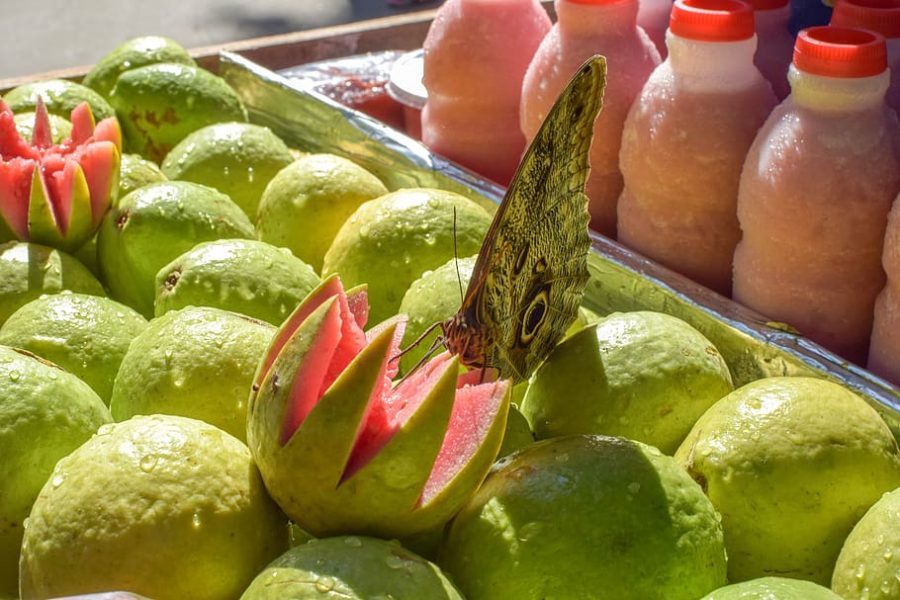Food: A Trip Around the World!
Exotic Guatemalan Guava.
Many people around the world have their own healthy exotic foods that have creative ingredients or plating styles. Distinctively, each exotic dish represents a different cultural background and its treasured heritage. Learning about these dishes not only broadens the culinary perspective but encourages a healthier lifestyle – one filled with hidden nutritional value and remarkable flavor. Let’s find out which foods are deemed unusual and healthy!
Beondegi
From South Korea hails a unique street food dish called Beondegi. Beondegi is a silkworm pupae dish with spices and is sold steamed or boiled in little paper cups with toothpick skewers making it easier to eat on the street. Kelly Lee, a Sophomore at Wilcox, states, “ I heard it can be good for your bones, memory when you are tired, and gives you a lot of calcium. Lots of people eat it with alcohol as a snack and it can be good for diets.” Even though silkworm pupae may not sound the most appealing at first, this unique ingredient is at the heart of this food delicacy and contains many health benefits. According to the Everything Silkworms, health benefits for Beondegi include reducing fatigue, minimizing diabetes contraction, preventing Alzheimer’s disease, and strengthening muscles. With many nutritional facts, Beondegi is not only healthy but conveniently popular throughout South Korea!
Takenoko
In Japan, Takenoko is a very popular exotic food. Takenoko is made of tender shoots and ivory-colored crisps of the bamboo that grow underground. Bamboo is a well-known and versatile ingredient, giving Takenoko a nutty and sweet flavor. It is a common vegetable that can be prepared in many different ways – depending on the region of the country. Mei Kusuyama, a sophomore at Wilcox, states, “ They are rich in nutrients, have a high fiber content, and contain almost no calories!” With bamboo only being grown in the subtropical regions of Asia, Takenoko is a delicacy. The dish consists of soy sauce, bamboo shoots, sugar, and dried bonito flakes, adding both flavor and texture. In high demand, Takenoko can be sold at Asian or Japanese restaurants. With unique ingredients and an intriguing taste, Takenoko’s simplicity is what draws in its fans!
Chhaprah
In India, Chhaprah seems foreign to natives themselves for its extreme rarity. Chhaprah is an unusual chutney made in a region by a tribe of Chhattisgarh. Chutneys are a side dish of breakfast items that are commonly eaten throughout India. With out-of-the-ordinary, captivating ingredients such as red ants combined with eggs, Chhaprah has a spicy, tangy flavor. According to Taste Trekkers, to prepare this chutney, red ants are dried and mixed with relevant salts and spices. It should be noted that most chutneys in India are vegan-based and do not contain any form of meat. Although this recipe is not frequented in India due to the subcontinent’s immense vegetarian population, Chhaprah’s nutritional value is immense. Some health benefits of eating this dish are enhancing protein and fiber content – both of which strengthen bones, muscles, and digestive ability.
Mok Huak
In Northern Thailand, Mok Huak is a rich dish made out of developing frog tadpoles, which resemble chicken nuggets in taste, as both are boneless. A special delicacy for the Northern Thai people, Mok Huak is served in both restaurants and on the streets. According to the Hua Hin Today, “Chefs who prepare this dish only want developing frog tadpoles or pollywogs but not a complete frogs.” This is because tadpoles are apt for fermentation with an indulgent fish sauce called “Pla Raa,” which is common in Thai cuisine. Fish sauce is extremely healthy and contains many beneficial vitamins. However, Mok Hauk is quite rare to eat for natives, considering its high price and seasonal value on rainy days.






